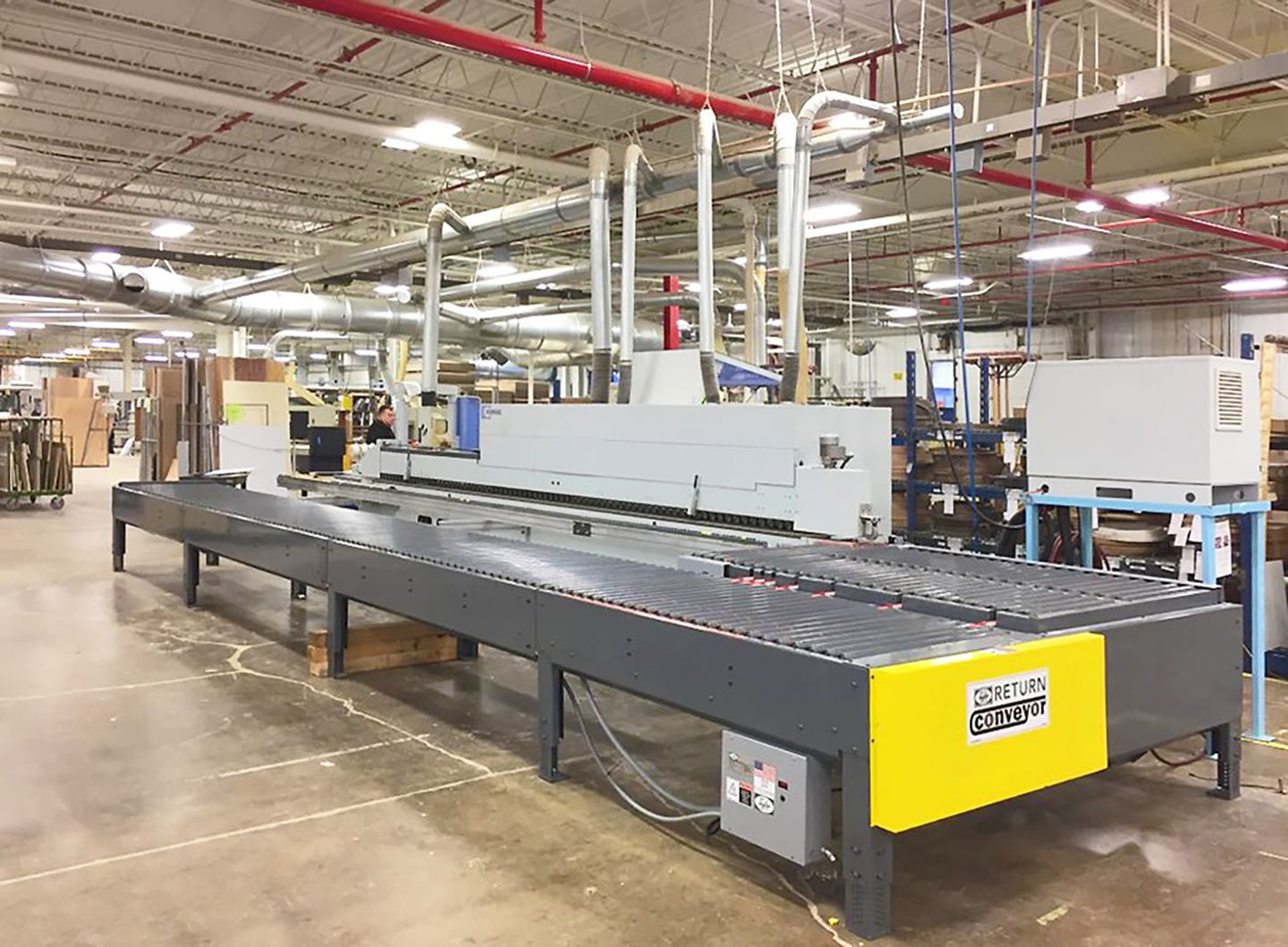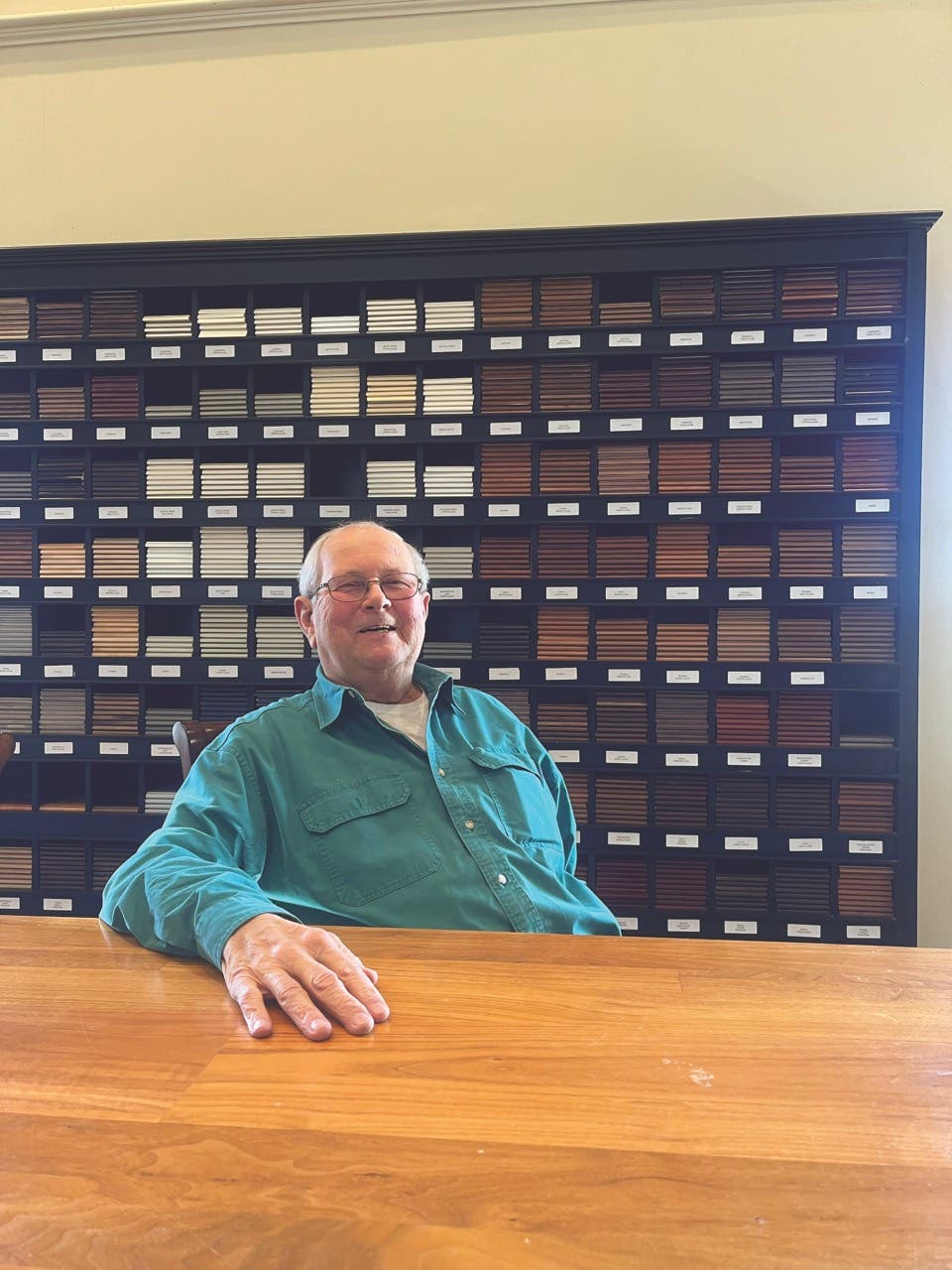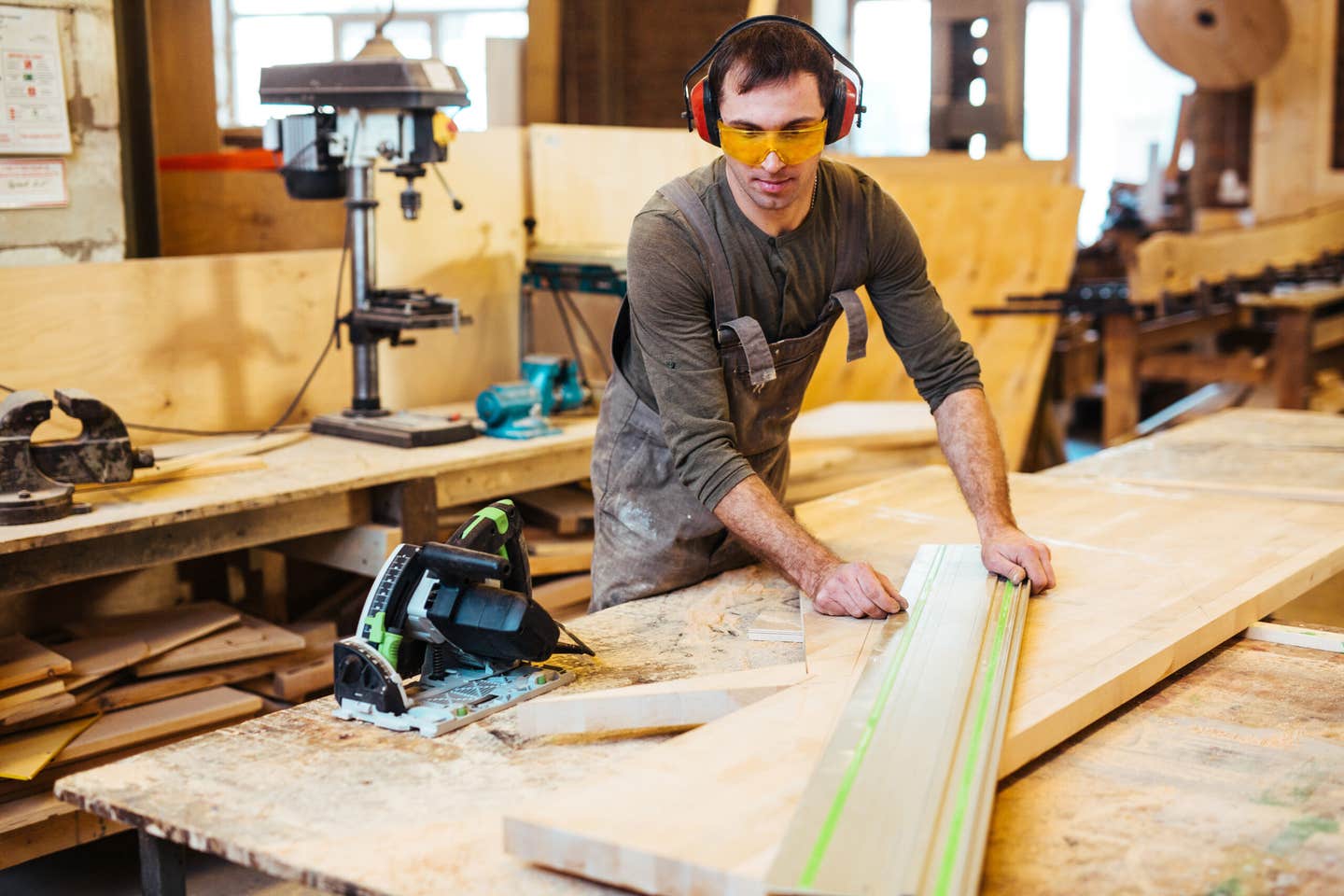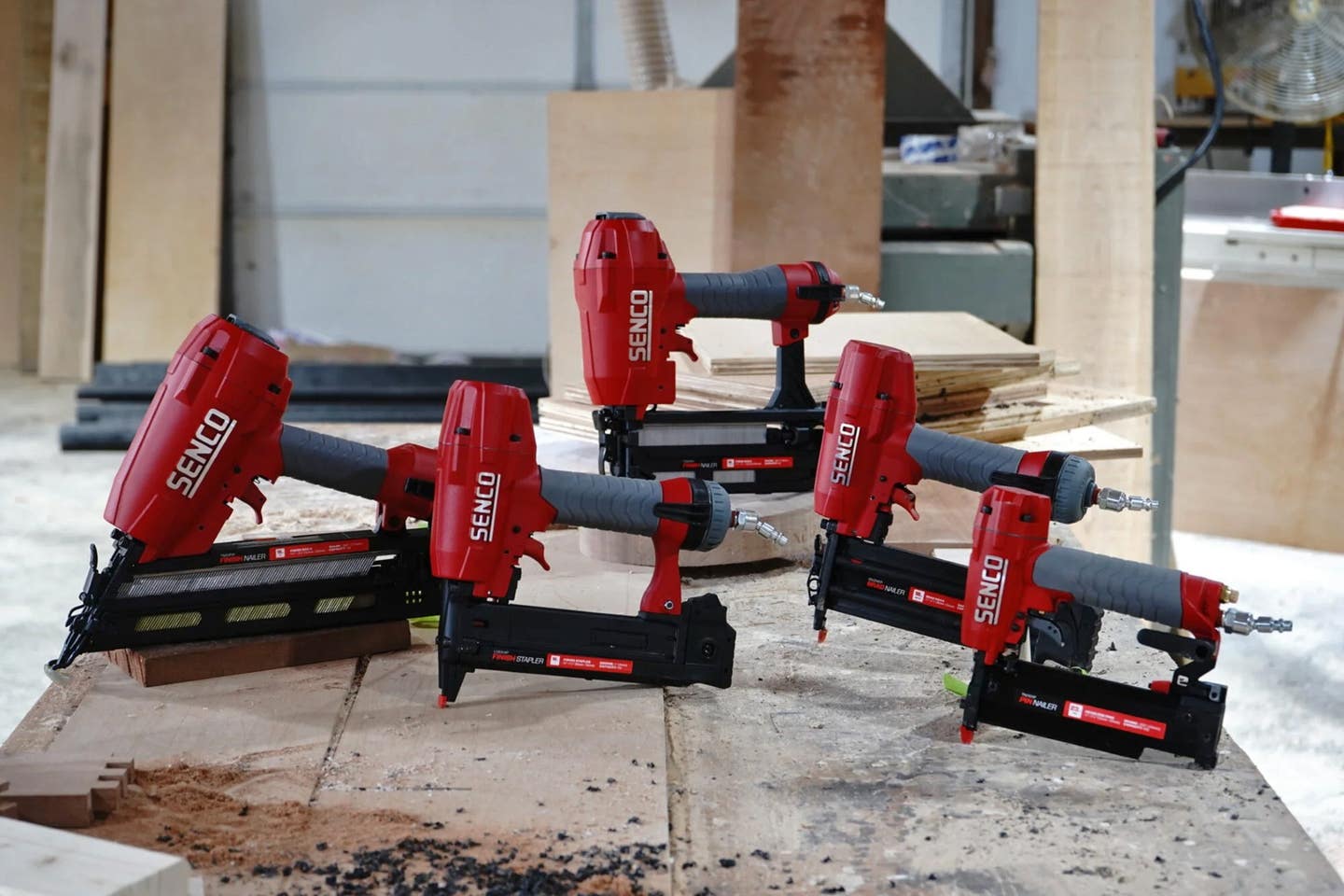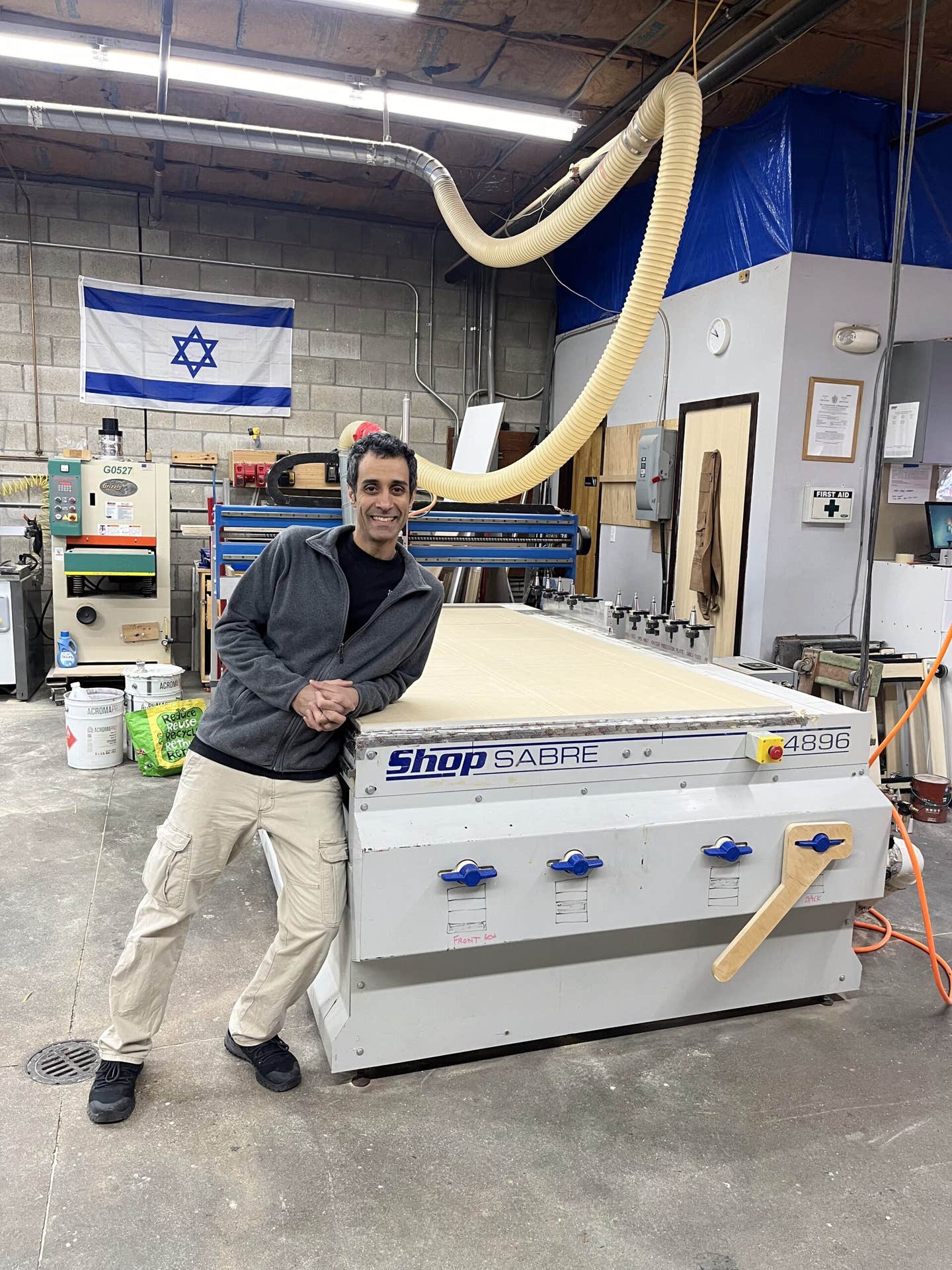Welcome to the future
This May, our woodshop built nine sink vanities for the bathrooms in a local hotel’s expansion project. There was a mix of left-hand and right-hand units, and the granite tops…
This May, our woodshop built nine sink vanities for the bathrooms in a local hotel’s expansion project. There was a mix of left-hand and right-hand units, and the granite tops tapered from 26” deep at one end to 8” deep at the other. As with most jobs, the schedule was tight and the granite didn’t arrive until the day the vanities were delivered.
The first countertop we unpacked was almost a foot short.
My heart sank. Then the contractor informed us that this wasn’t one of ours: it was for a separate Americans with Disabilities Act-compliant installation. Thankfully, the rest of the tops fit like gloves.
There were two lessons here. If at all possible, get the stone on site before you build the cabinets. And, secondly, read the packing slip to avoid cardiac arrest.
Working with materials that aren’t wood-based is nothing new to cabinetmakers or furniture builders. Sometimes a woodshop can work with stone, metal or plastic components in-house, but more often these will come from another supplier. If there’s a problem, we have to either make the non-wood parts fit the cabinets or make the cabinets fit the parts. For example, in the case of the hotel vanities, there was no way the granite was going to be remade in time if there was an error. We would have had to rebuild the casework to accommodate the stone.
If these had been traditional cabinets and had already been installed and rough-plumbed, the contractor would have had an interesting decision to make. Should he tear out the boxes, plumbing supply lines and wastes, and then repair the walls? Or would the hotel have had to cancel bookings until new granite tops arrived?
And, of course, that brings us to lawyers.
The hotel would blame the contractor, who in turn would either blame the granite manufacturer or the woodshop. Notice who is at the bottom of that trickle-down theory? To avoid being the last guy in line, a custom shop should have a caveat on every bid that says in essence that it is not liable for any losses that arise from delays beyond the shop’s control — and especially delays that occur when a secondary supplier delivers components that don’t meet spec. It’s well worth buying an hour of a lawyer’s time to get the wording on such a liability waiver just right. One would think that it’s completely obvious that the blame here lies somewhere other than with the woodshop, but courts often view things in funny ways when the facts aren’t explicit. It’s best to have everything spelled out and acknowledged. If the customer accepts the bid, they are also accepting this proviso.
Speaking of liability waivers, stone materials such as granite, travertine and marble are all brittle. Components made from these and similar products (either quarried or composite versions) can crack in the blink of an eye. That’s especially true of tops that have been prepped for sink mounts: they need to be supported properly when they are being moved and installed or the weak spots at the corners of the sink cutout will snap. If at all possible, let the stone company handle and install kitchen and bathroom countertops and don’t help or let any of your crewmembers help. Obviously, there will be times when it’s impossible to stay uninvolved. In those cases, I like to make sure that more than one witness hears me say that I am willing to help, but I won’t accept responsibility for any breakage. And I won’t touch the stone until the installer acknowledges hearing that. Granite can be quite expensive.
Quick fixes
With the emergence of comprehensive outsourcing during the last decade, options for cabinetmakers have changed for the better. If the hotel vanities mentioned above had been more traditional, rectangular boxes with doors and drawers, they would probably have been subbed out to a component supplier and delivered RTA (ready to assemble). In that case, if the stone didn’t fit, the boxes (or parts thereof) could have been reordered in a different size and delivered to the site on a fast track. So the nature and design of the casework or furniture has become an element in the equation. The more unusual the job, the less chance it will be outsourced. That’s particularly true of specs that were generated by a licensed architect. They don’t seem to like buying suits off the rack. Everything needs to be custom-tailored.
Of course, if a project is built entirely in-house, the shop’s crew will be very familiar with the job and might be in a good position to modify the wood elements quickly and easily. They’ll probably have some of the original species and cut and perhaps even some mixed stain ready to go.
That brings up construction methods. If a cabinet is going to be combined with stone, metal or plastic components that aren’t actually on site yet, then it’s a great idea to build it so that it is easily correctable. It’s a whole lot easier to downsize or modify casework that was assembled with pocket screws than it is to fix a project that was glued and clamped together. If the concept of using just pocket screws feels like underbuilding (and after a couple of decades of experience, the industry has produced an abundance of evidence to prove this isn’t so), then perhaps a combination method might be more appealing. Build it with pocket screws and do a dry fit to make sure the countertops fit. Once you know there are no modifications required, add some glue blocks. These can be cut, predrilled for pilot holes and countersunk at the woodshop and then screwed and glued in place on the job site. They can be placed in the usual spots behind toekicks and also on the inside corners of the boxes, high and out of sight. Glue blocks add an enormous amount of strength and they only take a few minutes to install.
Testing your mettle
While stone is the most obvious secondary material that a woodshop works around, there are times when a little metalworking comes into play. This can be as simple as moving a small amount of HVAC ductwork a few inches during an install or perhaps dropping in some stainless-steel appliance panels. The things to watch for in those instances are fairly rudimentary. Changing the size or direction of a feed duct is more likely to cause a problem than doing the same to a make-up (return) duct. With smartphones, it’s a simple matter to take a few photos of the piece that needs to be adjusted and send the images to an HVAC sub that specializes in that area. He/she can usually spot a potential problem right away and, if there’s a need for the pro to stop by, they’re already familiar with the layout and can bring the right materials and tools to the job site. That can save some downtime.
Working with metal can be an unfamiliar process for woodshop employees and they often tend to dismiss it as harmless. But sharp metal edges have sliced a lot of unwary fingers through the years and even a tiny cut can cause tetanus (lockjaw). Anyone who is working with metals needs to have a tetanus shot every few years. The Centers for Disease Control and Prevention actually recommends that all adults receive a booster vaccine once every 10 years, but few of us ever get around to doing that. Instead, hospitals and doctors routinely give patients with deep cuts a shot as soon as they show up at the clinic. Unfortunately, that doesn’t always work: it can take a couple of weeks for our bodies to grow antibodies that will fight the toxins. Tetanus is an infection caused by bacteria called clostridium tetani, which thrive in dirty environments such as places where metal sheets, bars or rods are stored directly on the ground or on racks in sheds where rodents live. The bacteria produce toxins that attack the nervous system, causing severe and sometimes even fatal muscle spasms. Thanks to the vaccine, there are only a few dozen cases in the U.S. every year. But there are a startling 60,000 worldwide.
Metal as a decorative element can add a huge new dimension to woodworking. Its visual impact is especially effective when sheets of copper or other highly colorful metals are laminated onto something like a curved reception desk or bar. It can transform a cabinet door, adding texture and vibrancy that few woods can match. Metal can also be used to diffuse reflective light or it can be brushed to reduce glare. Thin sheets of non-ferrous metal can be sandwiched between plywood to make clean cuts on a band saw, using metal-cutting blades. Aluminum can be crosscut on a miter saw: some carpenters still use an old circular saw blade installed backwards to get a smoother cut, but today’s metal-cutting blades do a great job of delivering clean edges.
If sheet metal is going to be used as a panel and it will be coated, it’s a good idea to apply the coating before assembly. Wood and metal expand and contract at very different rates, so unfinished edges on floating panels can show up in the middle of the dry season when the wood shrinks. Lacquer has traditionally been used as a coating, especially on brass, but many of the modern, relatively inert clear plastic finishes work well, too. And most of them are a little tougher than natural products. At one time lacquer was made from the secretions of the lac bug, which is a tropical species found in Asia, and it was historically used as a finish by woodworkers in India. Today, a couple of strains of the bug are still cultivated for manufacturing natural shellac (Kerria lacca and Laccifer lacca are among them). But most of the products that the woodworking industry now refers to as lacquer are actually polymers dissolved in volatile organic compounds (VOCs). These can be nitro-cellular or acrylic in nature and the carrier is often a cocktail of solvents that might include butyl acetate, xylene or toluene. If you’re spraying metal, vent properly and wear a mask.
Metal also enters the woodshop in the form of hardware. Through the years, less expensive base metal castings (the majority of which are now imported from China) have largely replaced steel, brass and stainless-steel pulls and knobs. Working with these softer metals can be a fun ride, especially when the machine screws strip out or parts shatter when dropped. If this hardware barely survives the woodshop, it’s not going to fare well in the ensuing decades in a kitchen. Spending a little more up front to purchase “real” metal can save time on installation and repairs and customers will almost universally appreciate the difference in quality.
The same is true of metal slides. There’s one heck of a difference between a cheap slide purchased at a big-box store and a reputable drawer slide brand ordered from a cabinet supply house. Excessive play in the inexpensive one, both vertically and horizontally, almost guarantees failure if the drawer is used often. Some woodworkers tend to pay a lot of attention to length and extension (half, full, etc.), but they sometimes fail to note whether the slides are rated appropriately for weight. It’s a good idea to ask the customer if the drawer will be used to store heavy items (such as gold bullion or perhaps a large collection of antique lead bullets).
Paying with plastic
There was a time when the only plastic to be found in a woodshop was laminate such as Formica. Today, manufacturers are offering entire drawer bodies cast in plastic, plus vacuum-formed drawer organizers, recycling centers and Lazy Susans. There are plastic knobs and pulls, thermofoil doors, edgebanding and vinyl-coated sheet stock.
And, of course, there are plastic countertops and sinks. Solid-surface acrylic, polyester or hybrid materials have been around for a long time and, among their advantages as countertop materials, is the fact that they can be worked with regular woodshop tooling. They also don’t require a coating and, as the color runs all the way through, repairs are easy. These plastics are food-safe, resistant to bacteria and generally don’t stain easily. The seams can be filled and blended, so they are virtually invisible. That’s also true of the seamless connection between countertop and sink, so there are no voids for bacteria to gather.
Thermoforming has added a new dimension to solid-surface materials and thinner sheets can now be formed and shaped to meet many innovative uses and needs. Plus, color can be controlled during the manufacturing process, so there is a wider array of shades and tones than are found in natural materials and the color is more uniform. These qualities make it especially appealing to architects and designers of commercial and industrial environments. The fact that a solid surface can be easily repaired and even completely refinished also makes it a great choice for high-traffic installations.
Working with plastic in the woodshop requires some investment in both planning and infrastructure. For example, controlling and handling plastic dust can be a challenge because of the static nature of the material. And crewmembers usually need to be certified in fabrication and installation by the product manufacturer, which requires an investment in training.
One advantage to being able to work with plastic solid-surface material is that contractors tend to hire the woodshop to do more than simply manufacture kitchen countertops. There is often a second bid for bathroom sinks, showers and bath surrounds that are designed to match the vanity tops.
As CNC routers become more affordable, widely used and versatile, there is an obvious path to new possibilities here. Combining the automated milling and shaping capabilities of CNC with the machining properties of solid-surface materials is step one. Adding more thermo-forming options and even 3-D print capabilities seems to point to applications far beyond mere sedentary countertops. Imagine the possibilities when a woodshop can combine the strength and beauty of natural products with dramatic, 3-D forming and milling of manmade materials.
If you’ve been to a major woodworking show lately, you realize that the future is already here. Every year, woodshops are becoming more and more capable of working with other materials. And as the technical skills and machines evolve, so do the design options.
One of the trends to watch in the next few years is the evolution of new, recycled materials. While we currently enjoy a temporary glut in the oil market, we all know that it won’t be long before shortages return. With limited worldwide oil reserves, a population that now exceeds 7 billion people and evolving consumer demand in China, India, Brazil and a host of other large countries, the day is not too distant when oil-based plastics will no longer be cheap and plentiful. As manufacturers turn increasingly toward recycled materials, woodshops and their machining, designing and fabrication capabilities are going to be key players in an evolving architecture.
Are you ready?
This article originally appeared in the July 2015 issue.



